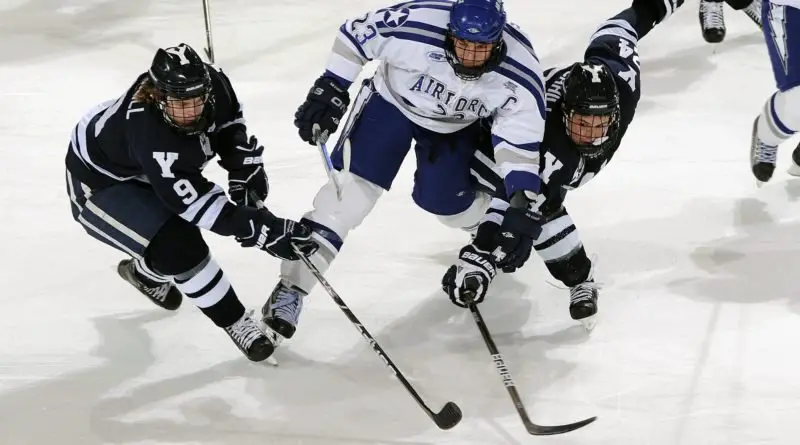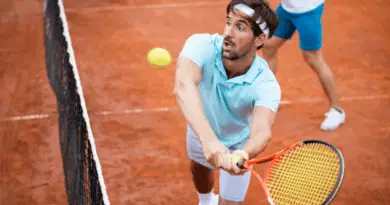Last modified on December 13th, 2020 at 10:27 pm
Equipment Needed To Play Hockey
Hockey is a sport that cannot be played safely without specific equipment. There are a few items that are absolutely necessary to actually play the game and other items that are necessary for avoiding serious injuries.
Brand new hockey equipment can be expensive, but there are ways to buy the necessities without emptying your wallet.
If you are a new player who wants to learn about hockey or want to enhance your hockey skills then this Hockey website can help you out in every aspect.
So what equipment do you need to being playing hockey? Let’s begin!
The Three Necessities
The three most necessary items for a hockey game are a pair of skates, a stick, and a puck. Without these items you cannot play the game.
But, these items are simply not enough to play the game safely. That little three-inch puck can be extremely dangerous after hockey players send it around the ice like a little rocket.
Without proper safety equipment, hockey players can end up with head injuries, broken bones, and lacerations as well as other more serious injuries to internal organs and the brain.
Get the right kind of skates
It is important to have the right kind of skates, especially since figure skates are not designed for the speed and quick stopping that is necessary for hockey. It is best to buy ice skates because they have smooth front edges on the blades.
Goaltenders have special skates that have boots set lower to the ground. They are designed to make the side-to-side movement more accessible and they have better ankle protection that player skates.
Sticks come in all sizes and materials
The hockey stick comes in a variety of different materials. The original ones were made of wood, but now they are most commonly made of composite materials to add strength and flexibility.
Most hockey players will have at least two sticks because sticks will break during games. It can also take hockey players some time to decide what type of stick they like, because the different materials have different weights and bending points.
Many players like to tape their sticks to get the right grip. You can learn about hockey stick length here, but it is best to choose a stick that reaches the tip of your nose with the blade on the ice and skates on your feet.
Goalies and players have different sticks. A player’s stick is designed for quick moves like passing the puck and moving it up the ice. Goalies need sticks with large blades that help them block pucks to prevent them from going into the net.
Protect your head with a good helmet and mask
The most important piece of protective equipment is the hockey helmet.
It should have a cage made of clear plastic or durable wire so your face is protected. The cage should not hinder your field of vision. There are several brands of hockey helmets available. A player’s helmet will be smaller than that of the goalie because of the nature of the game.
Goalies need to have helmets that protect their entire head and face, while players have smaller helmets that let them see side-to-side with more ease.
It is also important for hockey players and goalies to wear mouth guards when they are playing. The goalie mask covers the chin and neck more than the player’s helmet and mask do. The hockey goalie mask offers so much protection that many baseball catchers are turning to a similar style.
Gloves for different players
Hockey players and goalies also need protective gloves.
Hockey player gloves are designed to let players get a good handle on the stick while also allowing for more efficient stick handling.
Goalie gloves on the other hand are designed with two purposes.
- One is to hold the stick
- The other is for catching pucks
Goalie gloves are more heavily padded than player gloves, but again – it is due to the nature of the position. Goalies use their gloves to catch shots on goal like slap shots and one-timers, which can be hit extremely hard.
Along with a glove that lets goalies hold their sticks, they have a blocker gloves that they hold in the same hand as their sticks. This blocker glove lets them have more help with deflecting pucks. Then, in their other hand, they wear a trapper glove that lets them catch pucks that come their way.
Hockey pants keep you safe and let you move
Hockey pants or girdles are another important item of equipment. These are designed to cushion the legs in case pucks are hit at the thighs.
There are padded inserts that provide protection. Hockey pants are short and stop at the knees so players can stay warm and protected while having plenty of room to move. Most hockey pants come up high on the waist to keep the kidneys protected from errant pucks.
Protect your upper body
It is also important to protect the upper body, too. Shoulder pads that cover more than just the shoulder do this job.
These are different from the bulky pads that football players wear. Hockey shoulder pads actually cover the chest, collar, rib cage, shoulder blades, and the rest of the upper torso. They are lightweight, but protective so that hockey players can move freely. Goalies have them too but they have more padding because pucks come at a dangerous speed.
Hockey players, especially goalies, need to protect the vulnerable neck which is why many players will wear neck guards. These are different than the dangling neck guards that baseball catchers wear. The hockey neck guard looks more like a neck pad that wraps around the neck. They are easy to wear and inexpensive and they can make a real impact on a player who gets hit by a puck or a stick.
Elbow pads are necessities
The boards can really hurt, so it can be helpful to wear a pair of elbow pads. You put these on with Velcro straps and they will protect not just the elbow, but the forearm and upper arm, too. They can also protect the joint and arm from slashing, falls, and pucks, too.
Don’t be surprised if you are required to wear these if you play in any type of league, even casual recreational leagues. These guards, like all other equipment, come in different sizes to be sure you are buying elbow guards that fit your body.
The lower body needs padding, too
It is also important to protect your lower legs including the knees and shins.
Shin guards will cover the lower legs and fit perfectly into big hockey socks. There are also knee guards that come attached to the shin guard. They cover the knee cap and continue to the top of the boot of the skate.
Knees can be seriously injured in falls and shins can get whacked by pucks and sticks. Keeping the legs protected properly can keep you in the game for a long time.
Hockey goalies have specialized pads that offer extreme protection to their lower extremities. These pads are wide and can measure up to eleven inches across. Previous rules stated that the pads can be as tall as 38-inches to protect a sizeable part of the legs. Now, the rules have changed to allow players to have customized pads that fit their legs appropriately.
While it might be tempting to buy the biggest leg pads possible, it is actually best for the goalie to wear pads that fit. This allows the goalie to have mobility to properly play the position.
The big leg pads even cover the feet, with a small part of the skate boot toe showing through. Many players will get pads, blockers, and trapper gloves in coordinating styles.
Another important, and often neglected, piece of equipment is the pelvic protector for women and the jockstrap for men. Even though these parts are tucked inside of hockey pants, it is still necessary to give them the extra protection they deserve.
Specialized clothing helps
Players and goalies will also want to have a jersey to wear over their chest protectors. If you are playing on an organized team, it is best to have coordinating jerseys.
However, if you are playing a casual recreational league, you might not need to buy a special jersey. Not having coordinating jerseys is a good way for players to save money – especially since the rest of the equipment is so expensive.
Hockey socks are also useful pieces of equipment that are often overlooked.
These are specially designed to keep shin and knee pads in place. They look more like leg warmers than socks. They stay up by attaching to hockey garters that many players wear. Without the garters, the socks will fall and become baggy. Along with the big hockey socks, players will wear regular socks, sometimes several pairs, under their skates.
Where do you put all this equipment?
Finally, hockey players will need bags that are big enough to carry all of their gear.
Goalies will need even larger bags, simply because their knee pads and protective gear is so much bigger than player’s gear. These bags should be cleaned regularly because they can become smelly very quickly. It is helpful to have guards to put on the skate blades to protect them and the rest of your gear.




